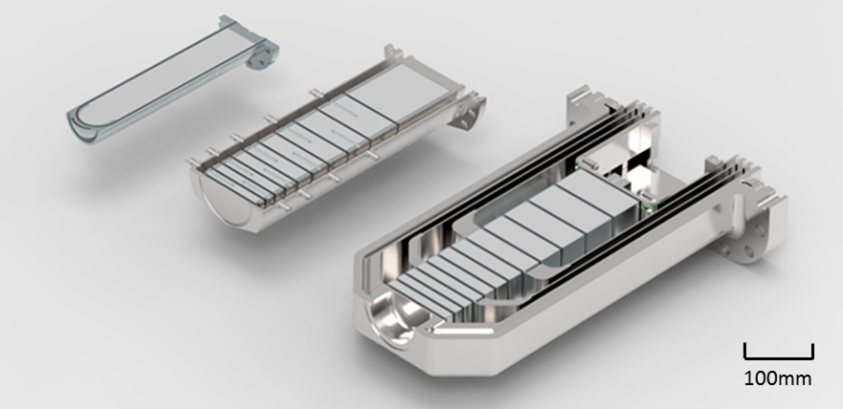We provided vital engineering analysis and design support to the ISIS Neutron and Muon Source during their TS1 (Target Station 1) Project.
This project aimed to provide a neutron flux increase and operational improvements to the station while maintaining the current high level of reliability, by redesigning the target, reflector, and moderator (TRaM) assembly.
Prior to the TS1 project, the design of these components had changed little since the facility was first opened in 1984.
With modern simulation software and analysis techniques, it is possible to produce much more highly optimised designs, delivering improved performance without increasing the facility’s power consumption.
As experts in engineering simulation and target design, we were called upon to provide analysis and design support for these critical components.
CAD model of the proposed TS1 Project TRaM (Target, Reflector and Moderator) assembly mounted on its support
.
ISIS TS1 Target
We produced a new design for the TS1 spallation target, which is about 60% lighter than the previous version – this improves neutron output by reducing the reabsorption of useful neutrons, as well as reducing the volume of radioactive scrap when the target is replaced.
The neutron-producing target plates are similar in size to the previous target, but the volume of the surrounding pressure vessel is greatly reduced.
We carried out detailed fluid, thermal, and structural simulations of target performance; this design assurance work provides confidence that the new target will operate reliably.
Engineering Simulation of the TS1 Project Target

Comparison of ISIS Targets. From left to right: the current TS2 target, TS1 project target, and previous TS1 target.
.
ISIS TS1 Reflector
In addition to the target, we also contributed to the redesign of the neutron reflector; a large piece of beryllium which surrounds the target and moderators.
The original ISIS reflector consisted of beryllium rods in a tank of water. The TS1 Project design uses solid beryllium blocks instead; these give better neutron output but are more difficult to keep cool.
We designed a system of water-filled aluminium cooling modules to be bolted to the outside of the reflector blocks and carried out thermal simulations to prove the design was feasible.
We were responsible for the detailed design and procurement of the cooling modules, including introducing the use of friction stir welding to produce modules that were less distorted and had better thermal contact than would otherwise have been possible.
CAD model of the TS1 Project beryllium reflector, with aluminium cooling modules attached to the outside
Prototype reflector cooling modules, friction stir welded (left) and conventionally welded (right).
Methane moderator research
The ISIS Neutron and Muon Source produces high-energy neutrons that can be fired at a range of targets, yet the neutrons initially have too much energy to be useful and so the total energy must be reduced.
One of the methods for doing this is to pass the neutrons through a liquid methane moderator with an aluminium ‘poison’ layer. However, using a liquid methane moderator introduces a new set of problems.
Within the moderator, hydrogen atoms break away from the methane molecules, forming hydrogen bubbles.
In addition, the methane molecules, which now have an available carbon bond, unite to form hydrocarbon chains, causing oil and other materials to form within the moderator, clogging the system up, and reducing the effectiveness of the moderators.
One of the key factors in the formation of hydrocarbon chains is how long the liquid methane remains in the moderator, aka the "residence time" before being recirculated: this is known as the methane "age".
We supported ISIS by actively developing new moderator geometries which encourage lower residence time and in turn, reduce the build-up of hydrocarbons, all without negatively affecting the interaction of the neutrons with the moderator.
To investigate the residence time of the fluid within the moderator, we used computational fluid dynamics (CFD) software to simulate fluid flow through the various geometries which we have designed.
(Left) Visualisation of the age of the liquid methane within the moderator, for a quarter of the geometry. The red and yellow zones display the regions where liquid methane has the highest age (6.8s), which corresponds to the recirculating streamlines in the right figure. (Right) Visualisation of the flow of the liquid methane through the moderator, areas where the streamlines recirculate correspond to the highest ages, left.
.
 (Left) Visualisation of the age of the liquid methane within an improved moderator geometry. The red and yellow zones display the regions where liquid methane has the highest age, which is 4.6s, 2s lower than the current geometry. (Right) Visualisation of the flow of the liquid methane through the improved moderator geometry.
(Left) Visualisation of the age of the liquid methane within an improved moderator geometry. The red and yellow zones display the regions where liquid methane has the highest age, which is 4.6s, 2s lower than the current geometry. (Right) Visualisation of the flow of the liquid methane through the improved moderator geometry.
.
Written by Dan Wilcox and Nathan O'Donoghue, members of the
High Power Targets team.
